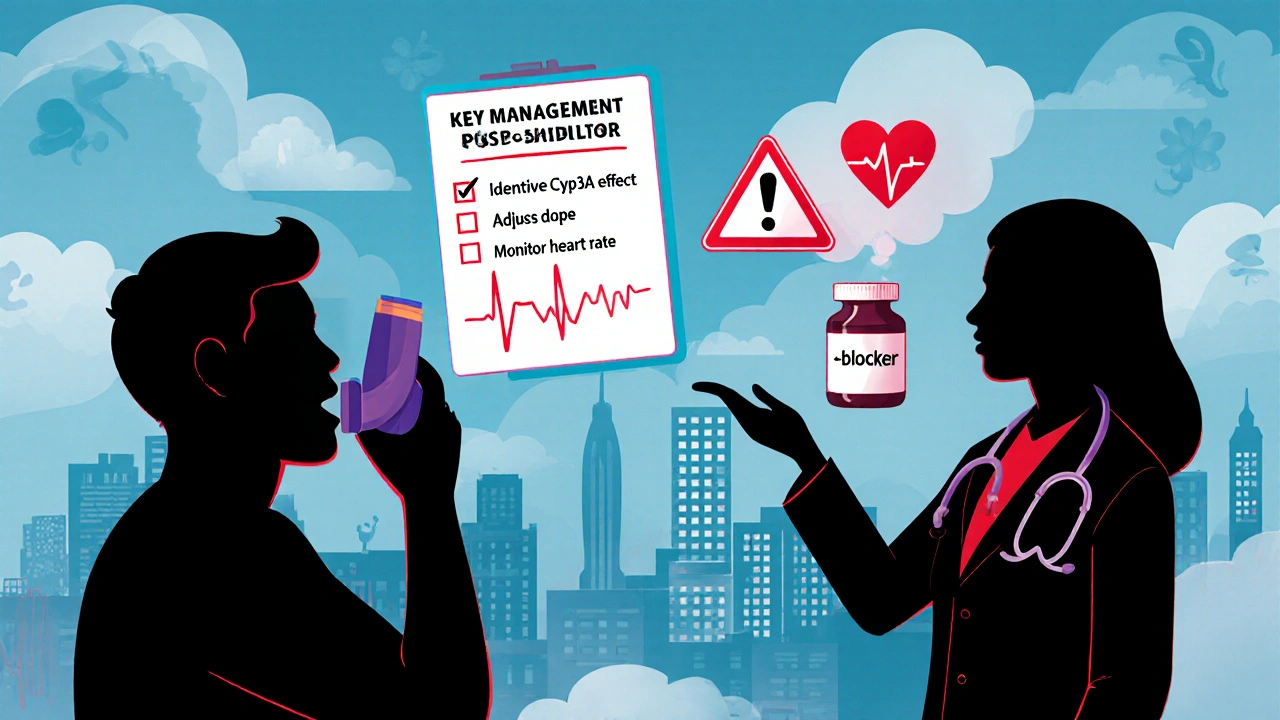When you pick up a prescription for Budesonide/formoterol is a fixed‑dose inhaler that combines an inhaled corticosteroid (budesonide) with a long‑acting β₂‑agonist (formoterol). It’s a go‑to for many people managing asthma or chronic obstructive pulmonary disease (COPD). The magic is that it reduces airway inflammation while keeping the airways relaxed, so you get fewer flare‑ups and better breathing.
But like any medication that sits in the bloodstream, it can bump into other drugs you’re taking. Some interactions are harmless, others can spark serious side effects or blunt the inhaler’s benefits. Below we break down the most common culprits, how they interact, and what you should do if you’re on a mixed regimen.
Quick Takeaways
- Most serious interactions involve drugs that affect the CYP3A4 enzyme or block β₂‑receptors.
- Antibiotics (macrolides, fluoroquinolones) and antifungals (ketoconazole, itraconazole) can raise budesonide levels.
- β‑blockers (especially non‑selective) may counteract formoterol’s bronchodilation.
- Monitor heart rate, blood pressure, and signs of adrenal suppression when risky combos are unavoidable.
- Always discuss new prescriptions or over‑the‑counter meds with your prescriber or pharmacist.
How Budesonide Formoterol Works
The inhaler delivers two agents in a single puff:
- Budesonide is a potent glucocorticoid that dampens airway inflammation by binding to intracellular glucocorticoid receptors, down‑regulating cytokines, and stabilising mast cells.
- Formoterol is a long‑acting β₂‑agonist (LABA) that relaxes smooth muscle in the bronchial walls, improving airflow for up to 12hours per dose.
Because budesonide is metabolised mainly by the liver enzyme CYP3A4, anything that slows that enzyme can let more steroid linger in the system, raising the risk of systemic side effects (e.g., throat irritation, adrenal suppression, bone loss). Formoterol, on the other hand, is cleared quickly but its effect can be blunted by drugs that antagonise β₂‑receptors.
Why Drug Interactions Matter
Side‑effects from the inhaler are usually local-hoarseness, oral thrush, or mild tremor. When interactions push drug levels higher or lower than intended, you can see:
- Excessive cortisol‑like activity (weight gain, mood swings, high blood sugar).
- Reduced bronchodilation, leading to worsening asthma or COPD symptoms.
- Cardiac arrhythmias or pronounced tachycardia caused by additive β‑agonist effects.
- In rare cases, severe adrenal crisis in patients who rely heavily on inhaled steroids.
Knowing the red‑flag combos lets you and your health‑care team act before a flare‑up turns into an emergency.

Common Interacting Drug Classes
| Drug Class | Typical Interaction | Clinical Impact | Management Tip |
|---|---|---|---|
| CYP3A4 inhibitors (e.g., ketoconazole, ritonavir) | Decrease metabolic clearance of budesonide | Higher systemic steroid exposure | Consider dose reduction or switch to a non‑CYP3A4‑metabolised inhaled steroid |
| CYP3A4 inducers (e.g., rifampin, carbamazepine) | Increase budesonide clearance | Reduced anti‑inflammatory effect | Monitor asthma control; may need higher inhaled dose |
| β‑blockers (especially non‑selective) | Antagonise formoterol’s β₂‑action | Diminished bronchodilation, possible bronchospasm | Avoid non‑selective agents; if needed, use cardio‑selective β‑blocker and watch lung function |
| Macrolide antibiotics (e.g., azithromycin) | Moderate CYP3A4 inhibition | Modest rise in budesonide levels | Short courses are usually safe; monitor for oral thrush |
| Fluoroquinolones (e.g., ciprofloxacin) | Can increase plasma concentrations of formoterol | Excessive tachycardia, tremor | Check heart rate; consider alternative antibiotic if possible |
Specific Drugs Worth Spotting
Below we dig into a handful of individual medicines that frequently pop up in prescriptions.
- Albuterol - A short‑acting β₂‑agonist often used as a rescue inhaler. When taken together with formoterol, the combined β‑agonist effect can cause noticeable tremor or palpitations. The trick is to keep rescue doses low and avoid over‑use.
- Theophylline - An older bronchodilator that is also a CYP3A4 substrate. It can compete with budesonide, slightly raising steroid levels. Regular blood level checks for theophylline help keep both drugs in check.
- Ritonavir - A protease inhibitor used in HIV therapy, it’s a potent CYP3A4 inhibitor. Patients on ritonavir often need a 25‑30% cut in their inhaled steroid dose or a switch to beclomethasone, which is less CYP‑dependent.
- Cimetidine - An H2‑blocker for acid reflux that weakly inhibits CYP3A4. Though the effect is modest, long‑term use paired with high‑dose budesonide could push cortisol‑like side‑effects. Consider an alternative like ranitidine or a proton‑pump inhibitor.
- Macrolide antibiotics - Azithromycin and clarithromycin inhibit CYP3A4 to a mild‑moderate degree. Short courses (≤5 days) are generally safe, but for chronic macrolide therapy (sometimes used in severe COPD), clinicians often lower the inhaled steroid dose.
- Non‑selective β‑blockers - Propranolol is the classic example. It will blunt formoterol’s bronchodilation and may precipitate bronchospasm. If a β‑blocker is essential (e.g., for migraine), a cardio‑selective agent like atenolol is preferred.
Notice the pattern? Anything that tweaks CYP3A4 or messes with β₂‑receptors is a candidate for interaction.

Managing Interactions in Real Life
Here’s a practical checklist you can run through whenever a new prescription lands on your desk.
- Identify whether the new drug is a CYP3A4 inhibitor, inducer, or a β‑blocker.
- Review the current dose of budesonide/formoterol. If you’re on a high‑dose inhaler (≥800µg budesonide per day), be extra cautious.
- Ask your prescriber if a dose adjustment or a different inhaled steroid (e.g., fluticasone) is possible.
- Monitor for signs of systemic steroid excess: unexplained weight gain, bruising, high blood sugar, or mood swings.
- Track lung function (peak flow or spirometry) especially after starting β‑blockers or high‑dose antibiotics.
- Schedule a follow‑up visit within 2-4weeks of any change.
Don’t try to play detective on your own; pharmacists are excellent allies for spotting interactions before they become problems.
When to Seek Immediate Help
If you notice any of these red flags after starting a new medication, treat them as an emergency:
- Sudden worsening of breathlessness or wheezing despite using your inhaler.
- Rapid heartbeat (>120bpm) accompanied by dizziness or chest pain.
- Severe oral thrush that spreads to the throat.
- Signs of adrenal insufficiency: extreme fatigue, low blood pressure, nausea, or vomiting.
Call your doctor, go to urgent care, or dial emergency services if symptoms surge.
Frequently Asked Questions
Can I take over‑the‑counter cold medicines with budesonide/formoterol?
Most OTC decongestants (like pseudoephedrine) are safe, but avoid products that contain non‑selective β‑blockers or high‑dose antihistamines that may increase heart rate. Always read the label and ask your pharmacist.
Do inhaled steroids cause weight gain?
At usual inhaled doses, weight gain is uncommon. When a strong CYP3A4 inhibitor raises systemic levels, a small increase in appetite or fluid retention can happen. Monitoring your weight after starting such drugs can catch the issue early.
Is it safe to use a nicotine patch while on budesonide/formoterol?
Nicotine patches don’t interact with CYP3A4 or β₂‑receptors, so they’re generally safe. However, nicotine can increase heart rate, which might add to the tremor you feel from formoterol. Keep an eye on how you feel.
What if I miss a dose of budesonide/formoterol?
Take the missed dose as soon as you remember, unless it’s almost time for the next one. Don’t double‑dose. Missing doses can let inflammation creep back, which may be confusing if you’re also on interacting drugs.
Are herbal supplements a concern?
Some herbs like St. John’s Wort induce CYP3A4 and can lower budesonide levels, while grapefruit juice inhibits it and may raise steroid exposure. Talk to a healthcare professional before adding any supplement.
Staying ahead of drug interactions isn’t about memorising a massive list; it’s about understanding the two main pathways-CYP3A4 metabolism and β₂‑receptor activity-and asking the right questions when a new medication is prescribed. With a little vigilance, budesonide/formoterol can keep your lungs clear while you go about your day.





nitish sharma
October 17, 2025 AT 20:26When managing asthma with budesonide/formoterol, clinicians should first assess the patient’s CYP3A4 profile.
Understanding whether concomitant medications inhibit or induce this enzyme informs dosage adjustments.
Inhibitors such as ketoconazole or ritonavir can elevate systemic budesonide exposure, increasing the risk of adrenal suppression.
Conversely, inducers like rifampin may reduce therapeutic efficacy, necessitating higher inhaled steroid doses.
Non‑selective β‑blockers, for example propranolol, antagonize the bronchodilatory effect of formoterol and may precipitate bronchospasm.
Selective β‑blockers present a lower risk but still require vigilant monitoring of lung function.
Antibiotics in the macrolide class, notably clarithromycin, exert moderate CYP3A4 inhibition and should be prescribed with caution for short courses.
Fluoroquinolones, particularly ciprofloxacin, can augment plasma concentrations of formoterol, potentially leading to tachycardia or tremor.
Pharmacists play a critical role in cross‑checking prescriptions for these interactions before dispensing.
Patients should be educated to report new symptoms such as unexplained weight gain, mood swings, or persistent oral thrush.
Regular peak‑flow measurements can detect subtle declines in bronchodilation efficacy when drug combinations change.
When a potent inhibitor cannot be avoided, dose reduction of the inhaled steroid or switching to a non‑CYP3A4‑metabolised inhaled corticosteroid is advisable.
Similarly, if an inducer is introduced, clinicians may need to increase the inhaled steroid dose while monitoring for side‑effects.
Documenting all medication changes in an up‑to‑date medication list facilitates communication among healthcare providers.
Overall, a systematic approach to evaluating drug–drug interactions enhances patient safety and preserves the therapeutic benefits of budesonide/formoterol.
Lyle Mills
October 27, 2025 AT 12:14Assessing interaction risk starts with a quick CYP3A4 scan; if an inhibitor is on board, anticipate a PK boost in budesonide.
Watch for β‑blocker antagonism that can blunt LABA efficacy, especially with non‑selective agents.
Short‑term macrolide courses are generally tolerable, but chronic use demands steroid dose tweaks.
Pharmacokinetic vigilance cuts down on adrenal axis disturbances and tachyarrhythmic events.
Keep the med list dynamic and feed it to the EHR for automated alerts.
Avril Harrison
November 6, 2025 AT 05:02Honestly, I’ve seen a few mates on the ward who got a nasty cough after starting a fluoroquinolone with their inhaler.
It’s a reminder that even a short antibiotic can mess with the bronchodilator.
If you’re feeling jittery or your heart’s racing, double‑check the meds you’ve just added.
Sometimes a quick chat with the pharmacist can sort it without changing your asthma plan.
Just keep an eye on the symptoms and you’ll be fine.
Sarah Hanson
November 15, 2025 AT 21:50Indeed, a diligent review of CYP‑interactions is paramount; any oversight may precipitate systemic glucocorticoid exces.
Wyatt Schwindt
November 25, 2025 AT 14:38Monitoring heart rate after adding a fluoroquinolone is a sensible precaution.
Natala Storczyk
December 5, 2025 AT 07:26Listen up, fellow Americans!! Our great nation produces the finest inhalers, but even the best can be sabotaged by foreign drug conspiracies!!! When a CYP3A4 inhibitor like ketoconazole sneaks into your regimen, it’s not just a side‑effect – it’s an assault on your respiratory freedom!!! Do NOT let a trickle of non‑selective β‑blockers cripple your lungs – stand strong, demand alternatives, and keep that bronchodilation blazing!! The stakes are high, the battle is within your airway, and only a vigilant American will emerge victorious!!
Rohit Sridhar
December 15, 2025 AT 00:14Hey, great energy! Just a heads‑up that while staying fierce, we also need to keep the science straight.
Look, if you’re on a strong CYP inhibitor, a modest dose cut of budesonide can keep you safe without losing control.
On the flip side, if you’re on an inducer, a small bump up might be all that’s needed.
Remember, your doctor is the ally in this fight – keep the communication open.
Stay positive, stay informed, and your lungs will thank you.